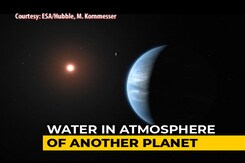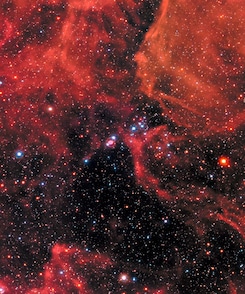Hubble
- All
- News
- Videos
- Web Stories
-

Hubble Telescope Spots Starless Dark Matter Cloud Cloud 9, Opening Window Into Dark Universe
- Saturday January 10, 2026
- Written by Gadgets 360 Staff
Hubble has discovered Cloud 9, a starless dark-matter cloud near galaxy M94, offering scientists a rare chance to study early galaxy formation. This failed galaxy, part of a class known as RELHICs, shows hydrogen gas but no star formation, highlighting the role of dark matter in shaping the cosmos and revealing potential hidden structures in our lo...
-
 www.gadgets360.com
www.gadgets360.com
-

James Webb Telescope Finds Rare Cosmic Dust in One of the Universe’s Most Primitive Galaxies
- Sunday January 11, 2026
- Written by Gadgets 360 Staff
A breakthrough has been made in the area of astrophysics as NASA’s James Webb Telescope has spotted two rare kinds of dust in the Early-Universe Analog.
-
 www.gadgets360.com
www.gadgets360.com
-

Hubble Telescope Detects Wake of Betelgeuse’s Hidden Companion Star, Confirming Long-Held Theory
- Friday January 9, 2026
- Written by Gadgets 360 Staff
Hubble Telescope observations have revealed a dense gas wake in Betelgeuse’s atmosphere, confirming the presence of a hidden companion star named Siwarha. The discovery explains the red supergiant’s unusual brightness changes and offers new insight into how massive stars evolve and shed material before becoming supernovae.
-
 www.gadgets360.com
www.gadgets360.com
-

Hubble Telescope Discovers Cloud-9, A New Type of Astronomical Object
- Tuesday January 6, 2026
- Science | Edited by Srishti Singh Sisodia
Cloud-9 contains no stars, making it a unique object for studying dark matter, and the cloud is composed of neutral hydrogen gas.
-
 www.ndtv.com
www.ndtv.com
-

Hubble Data Reveals Previously Invisible ‘Gas Spur’ Spilling From Galaxy NGC 4388’s Core
- Sunday January 4, 2026
- Written by Gadgets 360 Staff
The elliptical galaxy NGC 4388, situated in the Virgo Cluster approximately 60 million light-years from Earth, features an intriguing long tail of glowing gas, as shown in a recent image uploaded to the Hubble site in late 2025. This galaxy, viewed edge-on from Earth’s perspective, displays a bright spur of ionized gas spilling out from its core....
-
 www.gadgets360.com
www.gadgets360.com
-

Hubble Observations Turn Exoplanet Into Dust; Reveal Rare Double Asteroid Impact in Nearby System
- Saturday January 3, 2026
- Written by Gadgets 360 Staff
NASA’s Hubble Space Telescope has revealed that a vanished exoplanet near the star Fomalhaut was never a planet at all. Scientists discovered two rare, violent collisions between asteroid-sized bodies, producing glowing debris clouds that briefly mimicked planets. The findings offer a rare glimpse into how planetary systems evolve and how mislead...
-
 www.gadgets360.com
www.gadgets360.com
-

How 3I/ATLAS, Icy Lemmon And Cosmic SWAN Redefined The Sky In 2025
- Friday December 26, 2025
- Science | Edited by Astitva Raj
The year stood out for its memorable comet activity, with interstellar visitor 3I/ATLAS, along with comets C/2025 A6 (Lemmon) and C/2025 R2 (SWAN), drawing global attention.
-
 www.ndtv.com
www.ndtv.com
-

"Dracula's Chivito": Astronomers Use Hubble To Capture Largest Birthplace Of Planets Ever Found
- Thursday December 25, 2025
- Science | Edited by Srishti Singh Sisodia
Joshua Bennett Lovell, who is a co-investigator, said that they were "stunned" to see how asymmetric this disk is.
-
 www.ndtv.com
www.ndtv.com
-

Hubble Captures Gas Escaping Sideways Spiral Galaxy NGC 4388 in Virgo Cluster
- Sunday December 21, 2025
- Written by Gadgets 360 Staff
Hubble has captured a glowing plume of gas escaping the spiral galaxy NGC 4388 in the Virgo cluster. Moving through hot intracluster gas, the galaxy sheds material, partially energised by its central black hole. Multi-wavelength observations reveal the impact of both environmental forces and central activity on galaxy evolution.
-
 www.gadgets360.com
www.gadgets360.com
-

NASA Captures Asteroids Colliding Around Nearby Star Fomalhaut For The First Time
- Saturday December 20, 2025
- Science | Edited by Astitva Raj
The team will continue to monitor CS2 using Hubble for the next three years to observe its evolution.
-
 www.ndtv.com
www.ndtv.com
-

Hubble Captures Rare Collision in Nearby Planetary System, Revealing Violent Planet Formation
- Friday December 19, 2025
- Written by Gadgets 360 Staff
Astronomers using NASA’s Hubble Space Telescope have witnessed rare collisions between rocky bodies in the Fomalhaut system. The glowing debris clouds created by these impacts offer a unique glimpse into how planets form and highlight challenges in identifying true exoplanets.
-
 www.gadgets360.com
www.gadgets360.com
-

Interstellar Comet 3I/ATLAS Nears Earth on Dec. 19, Offering Rare Insights Into Cosmic Visitors
- Wednesday December 17, 2025
- Written by Gadgets 360 Staff
Interstellar comet 3I/ATLAS will make its closest approach to Earth on Dec. 19. Observing the comet provides scientists a rare opportunity to study dust and gases from its icy nucleus and learn more about material forming around other stars, expanding understanding of interstellar objects while posing no threat to our planet.
-
 www.gadgets360.com
www.gadgets360.com
-

Astronomers Witness Longest-Lasting Gamma-Ray Burst in History, 8 Billion Light-Years Away
- Tuesday December 16, 2025
- Written by Gadgets 360 Staff
A gamma-ray burst lasting over seven hours was recorded 8 billion light-years away, revealing a rare type of cosmic explosion and challenging current astrophysics models.
-
 www.gadgets360.com
www.gadgets360.com
-

Ahead Of Closest Approach To Earth, A Look At 3 Latest Images Of Interstellar Comet 3I/ATLAS
- Tuesday December 9, 2025
- Science | Edited by Srishti Singh Sisodia
The comet was detected on July 1, 2025, by the Asteroid Terrestrial-impact Last Alert System (ATLAS) survey telescope in Chile.
-
 www.ndtv.com
www.ndtv.com
-

Hubble Telescope Spots Starless Dark Matter Cloud Cloud 9, Opening Window Into Dark Universe
- Saturday January 10, 2026
- Written by Gadgets 360 Staff
Hubble has discovered Cloud 9, a starless dark-matter cloud near galaxy M94, offering scientists a rare chance to study early galaxy formation. This failed galaxy, part of a class known as RELHICs, shows hydrogen gas but no star formation, highlighting the role of dark matter in shaping the cosmos and revealing potential hidden structures in our lo...
-
 www.gadgets360.com
www.gadgets360.com
-

James Webb Telescope Finds Rare Cosmic Dust in One of the Universe’s Most Primitive Galaxies
- Sunday January 11, 2026
- Written by Gadgets 360 Staff
A breakthrough has been made in the area of astrophysics as NASA’s James Webb Telescope has spotted two rare kinds of dust in the Early-Universe Analog.
-
 www.gadgets360.com
www.gadgets360.com
-

Hubble Telescope Detects Wake of Betelgeuse’s Hidden Companion Star, Confirming Long-Held Theory
- Friday January 9, 2026
- Written by Gadgets 360 Staff
Hubble Telescope observations have revealed a dense gas wake in Betelgeuse’s atmosphere, confirming the presence of a hidden companion star named Siwarha. The discovery explains the red supergiant’s unusual brightness changes and offers new insight into how massive stars evolve and shed material before becoming supernovae.
-
 www.gadgets360.com
www.gadgets360.com
-

Hubble Telescope Discovers Cloud-9, A New Type of Astronomical Object
- Tuesday January 6, 2026
- Science | Edited by Srishti Singh Sisodia
Cloud-9 contains no stars, making it a unique object for studying dark matter, and the cloud is composed of neutral hydrogen gas.
-
 www.ndtv.com
www.ndtv.com
-

Hubble Data Reveals Previously Invisible ‘Gas Spur’ Spilling From Galaxy NGC 4388’s Core
- Sunday January 4, 2026
- Written by Gadgets 360 Staff
The elliptical galaxy NGC 4388, situated in the Virgo Cluster approximately 60 million light-years from Earth, features an intriguing long tail of glowing gas, as shown in a recent image uploaded to the Hubble site in late 2025. This galaxy, viewed edge-on from Earth’s perspective, displays a bright spur of ionized gas spilling out from its core....
-
 www.gadgets360.com
www.gadgets360.com
-

Hubble Observations Turn Exoplanet Into Dust; Reveal Rare Double Asteroid Impact in Nearby System
- Saturday January 3, 2026
- Written by Gadgets 360 Staff
NASA’s Hubble Space Telescope has revealed that a vanished exoplanet near the star Fomalhaut was never a planet at all. Scientists discovered two rare, violent collisions between asteroid-sized bodies, producing glowing debris clouds that briefly mimicked planets. The findings offer a rare glimpse into how planetary systems evolve and how mislead...
-
 www.gadgets360.com
www.gadgets360.com
-

How 3I/ATLAS, Icy Lemmon And Cosmic SWAN Redefined The Sky In 2025
- Friday December 26, 2025
- Science | Edited by Astitva Raj
The year stood out for its memorable comet activity, with interstellar visitor 3I/ATLAS, along with comets C/2025 A6 (Lemmon) and C/2025 R2 (SWAN), drawing global attention.
-
 www.ndtv.com
www.ndtv.com
-

"Dracula's Chivito": Astronomers Use Hubble To Capture Largest Birthplace Of Planets Ever Found
- Thursday December 25, 2025
- Science | Edited by Srishti Singh Sisodia
Joshua Bennett Lovell, who is a co-investigator, said that they were "stunned" to see how asymmetric this disk is.
-
 www.ndtv.com
www.ndtv.com
-

Hubble Captures Gas Escaping Sideways Spiral Galaxy NGC 4388 in Virgo Cluster
- Sunday December 21, 2025
- Written by Gadgets 360 Staff
Hubble has captured a glowing plume of gas escaping the spiral galaxy NGC 4388 in the Virgo cluster. Moving through hot intracluster gas, the galaxy sheds material, partially energised by its central black hole. Multi-wavelength observations reveal the impact of both environmental forces and central activity on galaxy evolution.
-
 www.gadgets360.com
www.gadgets360.com
-

NASA Captures Asteroids Colliding Around Nearby Star Fomalhaut For The First Time
- Saturday December 20, 2025
- Science | Edited by Astitva Raj
The team will continue to monitor CS2 using Hubble for the next three years to observe its evolution.
-
 www.ndtv.com
www.ndtv.com
-

Hubble Captures Rare Collision in Nearby Planetary System, Revealing Violent Planet Formation
- Friday December 19, 2025
- Written by Gadgets 360 Staff
Astronomers using NASA’s Hubble Space Telescope have witnessed rare collisions between rocky bodies in the Fomalhaut system. The glowing debris clouds created by these impacts offer a unique glimpse into how planets form and highlight challenges in identifying true exoplanets.
-
 www.gadgets360.com
www.gadgets360.com
-

Interstellar Comet 3I/ATLAS Nears Earth on Dec. 19, Offering Rare Insights Into Cosmic Visitors
- Wednesday December 17, 2025
- Written by Gadgets 360 Staff
Interstellar comet 3I/ATLAS will make its closest approach to Earth on Dec. 19. Observing the comet provides scientists a rare opportunity to study dust and gases from its icy nucleus and learn more about material forming around other stars, expanding understanding of interstellar objects while posing no threat to our planet.
-
 www.gadgets360.com
www.gadgets360.com
-

Astronomers Witness Longest-Lasting Gamma-Ray Burst in History, 8 Billion Light-Years Away
- Tuesday December 16, 2025
- Written by Gadgets 360 Staff
A gamma-ray burst lasting over seven hours was recorded 8 billion light-years away, revealing a rare type of cosmic explosion and challenging current astrophysics models.
-
 www.gadgets360.com
www.gadgets360.com
-

Ahead Of Closest Approach To Earth, A Look At 3 Latest Images Of Interstellar Comet 3I/ATLAS
- Tuesday December 9, 2025
- Science | Edited by Srishti Singh Sisodia
The comet was detected on July 1, 2025, by the Asteroid Terrestrial-impact Last Alert System (ATLAS) survey telescope in Chile.
-
 www.ndtv.com
www.ndtv.com





















